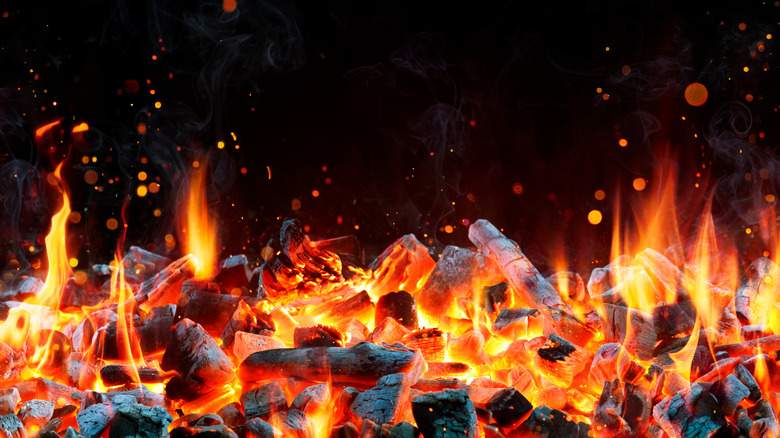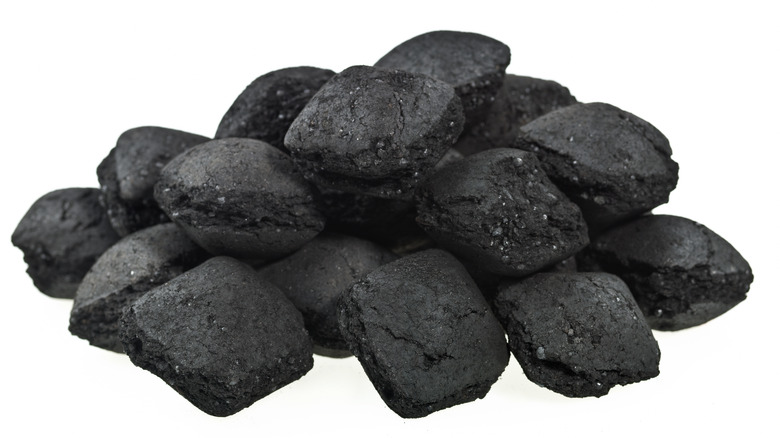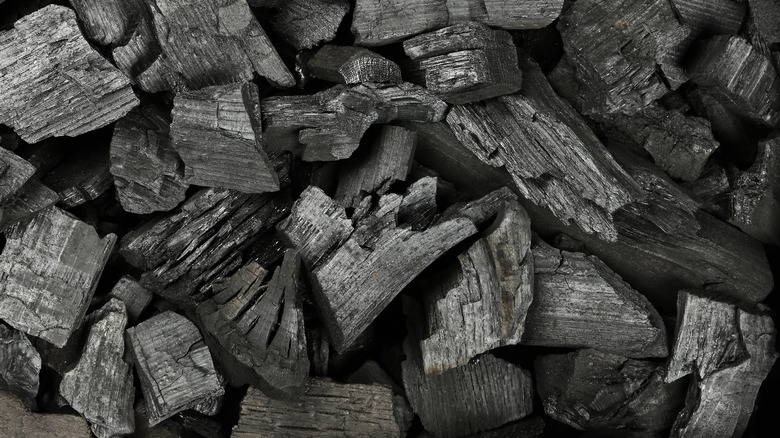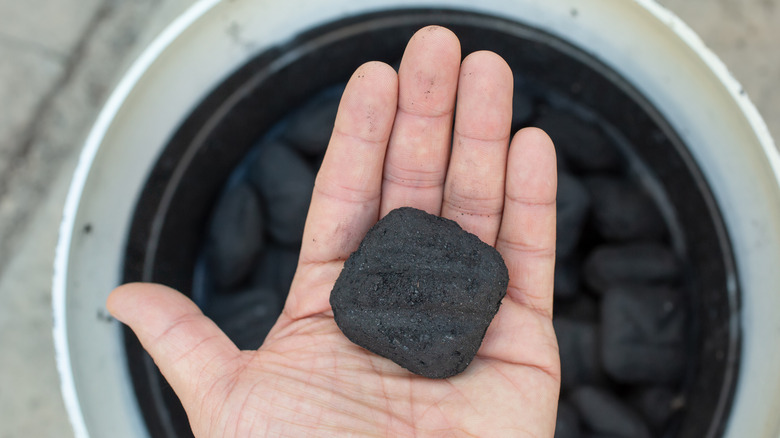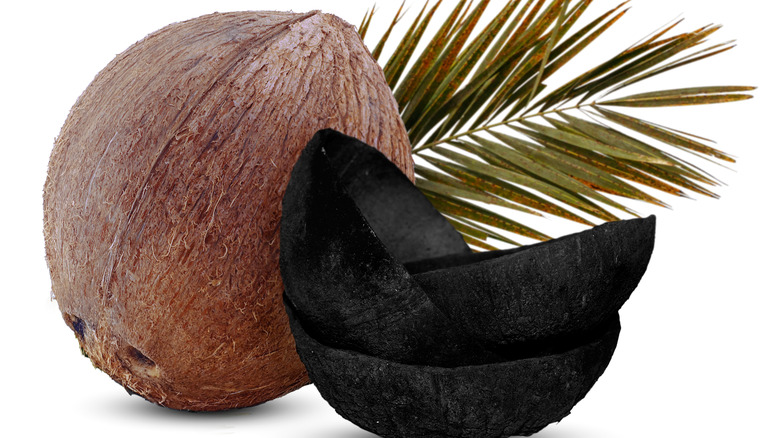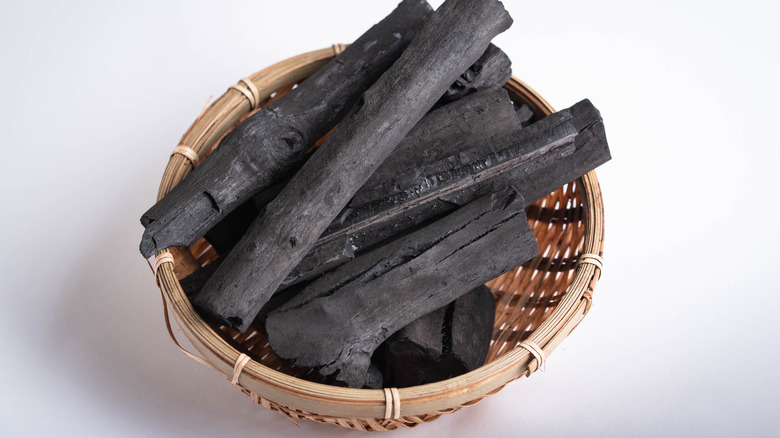5 Types Of Charcoal, Explained
It's hard to think of a cooking method more convivial than grilling. There's a deeply satisfying nature to the sizzle of a steak, the hiss of a vegetable skewer, and the sight of a flame. And when it comes to the utilized heat source, it's hard to beat the most ancient: charcoal. Sure, lighting the coals requires more patience than a gas grill, but the style generates much higher heat, enables smoking, and leads to better char. Plus, a charcoal fire produces an irreproducible aroma — making it an ingredient all its own on grill nights.
With five different charcoal types to choose from, it's worthwhile to make an attentive selection. Each type of charcoal is best suited to a certain cooking process and offers a unique flavor palette. Understanding the coal's components, as well as the manufacturing method, will take your grilling to the next level. Here's a breakdown of what the five varieties are all about.
Charcoal briquettes offer slow, dependable heat
Let's start with the most affordable and readily available charcoal type: briquettes. Invented in 1919, this coal variation came about as an industrial option from the start. Henry Ford wanted to reuse leftover wood debris from his factories, so he enlisted a chemist to create a solution. Researcher Orin Stafford devised a way to compress sawmill waste with tar and dust, all held together with corn starch. Ford popularized the sale of uniform bricks alongside grills, and the most iconic American charcoal emerged.
Such a backstory evinces the coal's pros — low cost and even burning. This type works best for slow heat applications, like large cuts of meat, whole birds, or open-fire Dutch oven cooking. And while the briquettes take longer to get hot, they're also dependable in poor weather conditions. Plus, their uniform size makes it easy to pile on more, making them handy for hours-long cooking. Additionally, since briquettes can lay flat, they achieve an even heat, so you don't need to worry about flare-ups with this type.
The biggest con of this type can be flavor. Made from various binders, including nitrate, and lime, they contribute undesirable chemical flavors to food. To minimize their aroma, burn them until they become white embers before adding your food.
Hardwood lump charcoal burns hot with a smoky aroma
Like briquettes, lump charcoal is also made from wood leftovers, including timber scraps, furniture, and even flooring. They're manufactured through a process called carbonization, where the oxygen in the environment is carefully limited, and by-products like methane, hydrogen, and water are burned away so the result is nearly pure carbon. Lump charcoal is often just a quarter of the weight of the original material, comprised of irregular pieces of coals and tar sediment. Unlike briquettes, there is no binder, which leads to a cleaner flavor.
The hardwood lumps are ready to be set alight right out of the bag. They burn quickly and hot, with abundant crevices created during stacking easing oxygen delivery. Additionally, in a grill with vents, it's easier to adjust the temperature of the flame. Lump charcoal is ideal for high-heat grilling — think veggies, burgers, steaks, skewers, and just about any other food that necessitates only a few minutes over heat. Additionally, the hardwood makeup translates its wood's flavor, leading to a more aromatic result.
The con with lump charcoal is that it's not a consistent heat, so it's easy to create too much char. Due to its irregular shape, pinpointing just how hot it gets may also be difficult. Plus, it'll burn through the coals quicker, not only ending the grilling session, but adding onto the cost. Depending on the coal's origins, its smoky flavor may be too pungent — so select the brand with care.
Hardwood charcoal briquettes generate consistent heat
Looking for slow-burning coal that still exhibits a pleasant taste? Turn to hardwood briquettes. This form of charcoal is manufactured from carbonized wood and pressed into uniform shapes. Adhesives are still present, but they're less noticeable, and the wood is more standardized — meaning more consistent burning. Like other briquettes, heat-up time takes longer; however, their density generates high, sustained warmth that lasts for hours. Plus, their standardized shape makes them easy to set alight. Seek out this option when slow-cooking foods that will best be infused with the coal's flavor, like whole fish, or pulled pork.
The biggest con with charcoal briquettes is the cost. Offering such uniformity with few industrial ingredients takes elaborate manufacturing. Hardwood briquettes also don't make for the best fuel in applications calling for direct flames, like a crispy pork belly recipe. When organizing an hours-long grill night where flavor matters, these briquettes are worth the splurge.
Coconut shell charcoal burns slowly with minimal flavor
Coconut shells are another useful fuel source. In addition to being sold whole, they're manufactured in briquette form. The process starts analogously to wood — the coconut shells are piled into a furnace and carbonized. The resultant shells burn into a product that's approximately 80% carbon, with some ash and other by-products left over. Next, they're bagged or pulverized and bound together with natural adhesives like tapioca starch.
Many producers utilize components that create a clean-burning, nearly odorless product. While coconut shells don't impart any flavor to the food, they also don't produce a lot of smoke, either a pro or con depending on your usage. They also produce very little ash and seldom spark. The carbon shells ignite quickly and produce heat for durations as long as three hours. The biggest plus is they have more potential energy than other types, and you can use as little as half compared to wood-based charcoal for the same amount of heat. Such qualities make them one of the best slow-cooking fuels.
Besides the rarity of coconut shells (they aren't a grocery store staple outside of tropical areas), the only other con is that while they produce heat as coals, they don't produce scorching flames, which you might want for some applications, like a tuna steak, for example.
Binchotan charcoal creates a consistent heat source
Last comes the rarest of the charcoal types — binchotan. Sourced exclusively from Japan, this charcoal type utilizes a special type of oak called Ubame. Grown on hilly terrain unique to only a few regions, it's favored for its density and internal grain. After harvesting, it undergoes a unique firing process. Oak branches, usually with the bark left on, are placed into a large oven. After lighting, the kiln is sealed by hand, with only a few small holes enabling oxygen flow. Firing at a low temperature, the wood spends nine days being slowly turned into charcoal. The final step in the process reintroduces oxygen into the kiln, where temperatures then reach 1800 Fahrenheit, hardening the charcoal and increasing its carbon content to a whopping 95%.
Such a laborious process creates a charcoal with unique characteristics. These coals can burn consistently hot for an exceptionally long time — up to 5 hours, and they don't produce an odor or any smoke. In fact, their sizzling temperatures only elevate flavors further, as food drippings produce an aromatic steam, particularly when utilized, in yakitori cooking, on a Japanese grill known as a konro.
Unsurprisingly, such qualities are why binchotan is regarded as top-of-the-line charcoal. However, it's both hard to find and expensive. And it's often not regarded as the best choice for an American-style barbecue, which benefits from those aromatic smoky notes.
